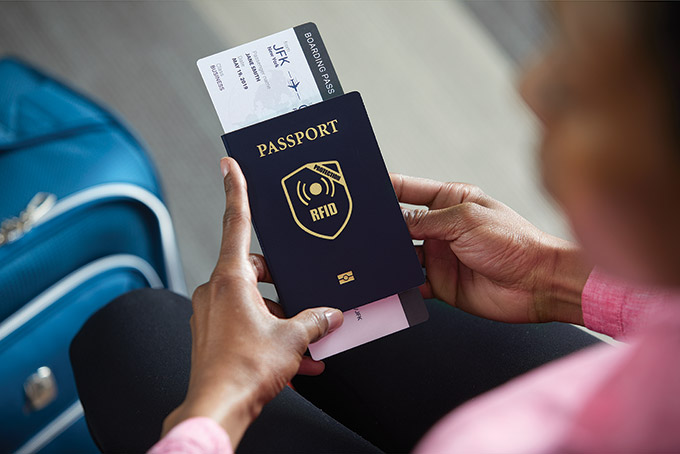Around the world, e-Passports (also called electronic passports, digital passports or biometric passports) are some of the most advanced documents produced today.
It’s the combination of complex, ingenious design features, material components and production processes that help make them so incredibly secure. While design options continue to evolve to benefit global security and traveler convenience, PPG TESLIN® substrate continues to be a material of choice for e-Passports.
As a critical design component in more than 75 national e-Passport programs, Teslin substrate is a trusted, proven, and cost-effective substrate solution. Passport issuers favor Teslin substrate for securing and protecting embedded data in e-Passport inlays and electronic covers (e-Covers) because it is an exceptionally flexible, protective, highly bondable and inherently tamper-resistant material. These attributes help ensure that documents using Teslin substrate will exceed stringent security criteria and perform without fail for the 10-year service life that national e-Passport programs require.
PPG Teslin RF Shielding Material
Governments and passport designers seeking even greater levels of security and personal identity protection have the option of choosing Teslin RF shielding material. Flexible, moldable and affordable, this next-generation product combines the durability and built-in security of Teslin substrate with proven signal-shielding strength that meets ISO/IEC 14443 criteria.
By adopting Teslin RF shielding material in passports with e-Covers, e-Data pages or e-Middle pages, customers can add another layer of security to their new or existing e-Passport designs with a minimal increase in production costs. Even when travelers’ e-Passports are slightly open, the signal-blocking and detuning strength of this powerful, versatile material provides a robust layer of protection against fraudulent access to personal data.
To learn more about Teslin RF shielding material and how it can be customized to meet specific shielding performance requirements, click here.
The Early Choice. The Reliable Choice.
 Since the very start of e-Passport deployment globally, Teslin substrate has been an integral element in e-Passport document specifications. Issuers and producers continue to specify Teslin substrate for use in e-Covers because of its unique material properties and superior performance, compared to other paper or synthetic substrates. Worldwide, most system integrators, as well as the vast majority of government issuing authorities, government printing offices, and security printers, endorse the use of Teslin substrate.
Since the very start of e-Passport deployment globally, Teslin substrate has been an integral element in e-Passport document specifications. Issuers and producers continue to specify Teslin substrate for use in e-Covers because of its unique material properties and superior performance, compared to other paper or synthetic substrates. Worldwide, most system integrators, as well as the vast majority of government issuing authorities, government printing offices, and security printers, endorse the use of Teslin substrate.
Best-in-Class Tamper-Evident Security
Teslin substrate performs exceptionally well for e-Covers. While it is durable and flexible for handling, it also provides an important deterrent to fraud. If the e-Cover is subjected to document tampering, Teslin substrate will permanently distort and irreversibly break. In fact, PPG has received no reports of successful breaches of Teslin substrate e-Covers since the material was adopted for e-Covers more than a decade ago.
Second-to-none Flexibility and Exceptional Durability
E-Passports are often exposed to repeated and harsh mechanical stresses during their service life. Teslin substrate’s unique microporous structure provides a cushion to protect embedded RFID inlay electronics, even under the toughest usage conditions.
The protective qualities of Teslin substrate combined with its durability and flexibility, are outstanding. E-Passports using Teslin substrate easily meet and exceed the 10-year document lifespan that most countries mandate for their international travel documents.
Trust Teslin Substrate for Next-Generation e-Passport Design
Globally, e-Passports with e-Covers continue to be the prevailing form factor for e-Passports because they’re cost-effective, flexible, durable and highly secure.
New design options are emerging for governments upgrading or developing new e-Passport programs. Prevalent options incorporate a polymeric data page (as a substitute to a laminated paper data page) either with or without electronics. Both form factors offer some benefits, but also entail a significant cost premium and do not comprehensively address all common types of document fraud, counterfeiting, and alteration, in particular.
Most importantly, whether they opt for a polymeric or a paper data page, many issuers and producers continue to prefer to retain an e-Cover design that enables to keep printed and digital data in separate e-Passport components rather than adopt an e-Datapage design that implies placing all sensitive data within a single location that then becomes the sole focus for fraudulent attacks.
Integrate the Benefits of Teslin Substrate into Your e-Passport e-Cover
When you combine the superior security benefits of Teslin substrate with the lower costs of e-Covers compared to e-Datapages, it is easy to understand why so many governments and e-Passport producers still prefer conventional e-Cover design.
A highly secure document that is difficult to alter or counterfeit is the goal of any government, and Teslin substrate is trusted and proven to meet the challenge.
Contact us to request samples and learn more about the high-performance benefits of Teslin substrate synthetic paper for e-Passport e-Cover applications.